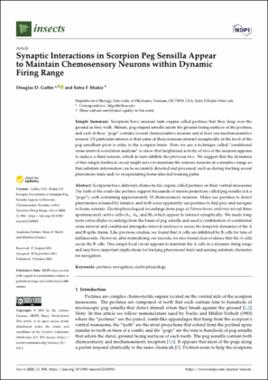| dc.contributor.author | Gaffin, Douglas D. | |
| dc.contributor.author | Shakir, Safra F. | |
| dc.date.accessioned | 2021-11-12T22:09:36Z | |
| dc.date.available | 2021-11-12T22:09:36Z | |
| dc.date.issued | 2021-10-03 | |
| dc.identifier.citation | Gaffin DD, Shakir SF. Synaptic Interactions in Scorpion Peg Sensilla Appear to Maintain Chemosensory Neurons within Dynamic Firing Range. Insects. 2021; 12(10):904. https://doi.org/10.3390/insects12100904 | en_US |
| dc.identifier.uri | https://hdl.handle.net/11244/331246 | |
| dc.description.abstract | Scorpions have elaborate chemo-tactile organs called pectines on their ventral mesosoma. The teeth of the comb-like pectines support thousands of minute projections called peg sensilla (a.k.a. “pegs”), each containing approximately 10 chemosensory neurons. Males use pectines to detect pheromones released by females, and both sexes apparently use pectines to find prey and navigate to home retreats. Electrophysiological recordings from pegs of Paruroctonus utahensis reveal three spontaneously active cells (A1, A2, and B), which appear to interact synaptically. We made long-term extracellular recordings from the bases of peg sensilla and used a combination of conditional cross-interval and conditional interspike-interval analyses to assess the temporal dynamics of the A and B spike trains. Like previous studies, we found that A cells are inhibited by B cells for tens of milliseconds. However, after normalizing our records, we also found clear evidence that the A cells excite the B cells. This simple local circuit appears to maintain the A cells in a dynamic firing range and may have important implications for tracking pheromonal trails and sensing substrate chemistry for navigation. | en_US |
| dc.description.sponsorship | Open Access fees paid for in whole or in part by the University of Oklahoma Libraries. | en_US |
| dc.language | en_US | en_US |
| dc.rights | Attribution 4.0 International | * |
| dc.rights.uri | https://creativecommons.org/licenses/by/4.0/ | * |
| dc.subject | Pectines | en_US |
| dc.subject | Navigation | en_US |
| dc.subject | Electrophysiology | en_US |
| dc.title | Synaptic Interactions in Scorpion Peg Sensilla Appear to Maintain Chemosensory Neurons within Dynamic Firing Range | en_US |
| dc.type | Article | en_US |
| dc.description.peerreview | Yes | en_US |
| dc.identifier.doi | 10.3390/insects12100904 | en_US |
| ou.group | College of Arts and Sciences::Department of Biology | en_US |

